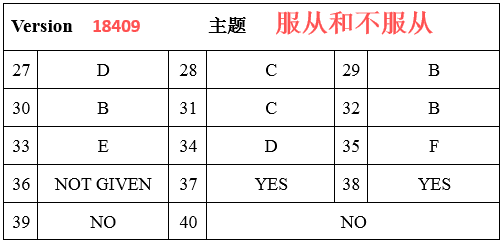托福考试中,托福阅读的文章需要同学们根据不同类型的托福文章题材,掌握一定的解题技巧。下面小编就和大家分享托福阅读学术类文章解题技巧,来欣赏一下吧。
托福阅读学术类文章解题技巧
1.托福阅读文章之学术篇的结构
在托福阅读学术性文章中,一般需要具备三个组成部分:
(1)Topic 话题:即文章的主角是什么。比如讲解某个科学理论、研究某种社会现象,探讨某个历史事件;
在托福文章中,这种导入性信息往往出现在篇首位置。考生可以根据篇首段信息对整篇文章所要讨论的核心内容有所了解;
(2)Aspects 方面:即将篇首的话题延伸拓展为若干个方面进行阐述说明。若话题为某个科学论点,则方面可能分为若干个支持论据;若话题为某种自然现象,则方面可能分为若干个内外成因;若话题为某个历史事件,则方面为几段发展时期;
在这种托福阅读题材中,往往依照各个方面之间的层次关系,将各个方面拆分为若干个独立的自然段落,共同组成行文主体;
(3)Attitude态度:即文章的作者对于所讨论话题持怎样的态度。或是积极肯定,或是消极否定,或是保持中立。
在托福文章中,态度往往是被较多的淡化甚至有可能省略不提。Topic话题 + Aspects方面 + Attitude态度,这三要素加起来就是标准学术论文体的"T+A+A篇章结构"。托福文章大都遵循这种结构,考生通过篇首段落信息来把控整个文章话题及大致讨论方向,再抓住文章的各个段落主旨,便可洞悉整个文章脉络和逻辑结构。
2.托福阅读学术性文章的段落结构
托福阅读学术性文章的自然段落,一般需要具备两个组成部分:(1) Topic Sentence
主旨句:表达段落的主旨,即本段想要表达的核心内容是什么;
(2) Detail 细节:为了详细说明段落中心含义,所罗列的相关支持内容,即本段通过哪些例证来阐明主旨句。
Topic Sentence主旨句 + Detail细节,这两个要素加起来就是标准学术论文体的"TS+D段落结构"。托福文章段落大都遵循这种结构,考生通过段落主旨句就可以把握该段的中心含义。
总结:当考生们了解了这种TAA篇章结构和TS+D段落结构的行文规律后,对文章框架的把握就会做到心里有数,更有利于提高托福阅读速度和定位有效信息的准确度。
托福阅读背景知识:工业革命
正是因为工业革命的重要性,托福考试非常青睐它--工业革命的发展特点、历史甚至与之相关的蒸汽机、能源问题都是在阅读和听力中经常出现的话题。
官方真题Official26中就曾出现蒸汽机以及蒸汽机改良相关的细节描述:
In the late 1700s James Watt designed an efficient and commercially viable steam engine that was soon applied to a variety of
industrial uses as it became cheaper to use....A rotary(转动的,旋转的)engine attached to the steam engine enabled shafts (转动轴)to be turned and machines to be driven, resulting in mills using steam power to spin and weave cotton.
同一篇中,谈到工业革命中钢铁行业的发展,也具体到很多细节:
The availability of steam power and the demands for new machines facilitated the transformation of the iron industry. Charcoal(木炭),made from wood and
thus in limited supply, was replaced with coal-derived coke(焦炭)(substance left after coal is heated)
as steam-driven bellows(风箱)came into use for producing of raw iron. Impurities were burnt away with the use of coke, producing a high-quality refined iron(精铁).Reduced cost was
also instrumental in developing steam-powered rolling mills capable
of producing finished iron(高纯度的铁)of various shapes and sizes.
这里帮大家整理一下工业革命主要产业及背景大家要记得记笔记哦。
纺织产业(textile industry):
纺织机的演化:飞梭(Flying shuttle)→杼箱→珍妮纺纱机(Spinning Jenny)→骡机(Spinning Mule)→水力织布机→蒸汽动力驱动运输行业革新:
1776年煤矿(colliery)中使用铁轨;
1814年运煤的蒸汽机车问世;1825年世界上第一条铁路;
1844年,英国铁路长达2235英里;
钢铁行业革新:
1709年,焦炭(coke)取代木炭(charcoal)炼铁;
1750年,坩埚炼钢工艺(steelmaking process),欧洲历史上钢首次被熔化冶炼(smelt)。
托福阅读真题原题+题目
The first flying vertebrates were true reptiles in which one of the fingers of the front limbs became very elongated, providing support for a flap of stretched skin that served as a wing. These were the pterosaurs, literally the winged lizards. The earliest pterosaurs arose near the end of the Triassic period of the Mesozoic Era, some 70 million years before the first known fossils of true birds occur, and they presumably dominated the skies until they were eventually displaced by birds. Like the dinosaurs, some the pterosaurs became gigantic; the largest fossil discovered is of an individual that had a wingspan of 50 feet or more, larger than many airplanes. These flying reptiles had large, tooth-filled jaws, but their bodies were small and probably without the necessary powerful muscles for sustained wing movement. They must have been expert gliders, not skillful fliers, relying on wind power for their locomotion.
Birds, despite sharing common reptilian ancestors with pterosaurs, evolved quite separately and have been much more successful in their dominance of the air. They are an example of a common theme in evolution, the more or less parallel development of different types of body structure and function for the same reason — in this case, for flight. Although the fossil record, as always, is not complete enough to determine definitively the evolutionary lineage of the birds or in as much detail as one would like, it is better in this case than for many other animal groups. That is because of the unusual preservation in a limestone quarry in southern Germany of Archaeopteryx, a fossil that many have called the link between dinosaurs and birds. Indeed, had it not been for the superb preservation of these fossils, they might well have been classified as dinosaurs. They have the skull and teeth of a reptile as well as a bony tail, but in the line-grained limestone in which these fossils occur there are delicate impressions of feathers and fine details of bone structure that make it clear that Archaeopteryx was a bird. All birds living today, from the great condors of the Andes to the tiniest wrens, trace their origin back to the Mesozoic dinosaurs.
1. What does the passage mainly discuss?
(A) Characteristics of pterosaur wings
(B) The discovery of fossil remains of Archaeopteryx
(C) Reasons for the extinction of early flying vertebrates
(D) The development of flight in reptiles and birds
2. Which of the following is true of early reptile wings?
(A) They evolved from strong limb muscles.
(B) They consisted of an extension of skin.
(C) They connected the front and back limbs.
(D) They required fingers of equal length.
3. The word literally in line 3 is closest in meaning to
(A) creating
(B) meaning
(C) related to
(D) simplified
4. It can be inferred from the passage that birds were probably dominant in the skies
(A) in the early Triassic period
(B) before the appearance of pterosaurs
(C) after the decline of pterosaurs
(D) before dinosaurs could be found on land.
5. The author mentions airplanes in line 8 in order to
(A) illustrate the size of wingspans in some pterosaurs
(B) compare the energy needs of dinosaurs with those of modern machines
(C) demonstrate the differences between mechanized flight and animal flight
(D) establish the practical applications of the study of fossils
6. The word They in line 10 refers to
(A) powerful muscles
(B) bodies
(C) jaws
(D) flying reptiles
7. According to the passage , pterosaurs were probably not skillful fliers (lines 10-11) because
(A) of their limited wingspan
(B) of their disproportionately large bodies
(C) they lacked muscles needed for extended flight
(D) climate conditions of the time provided insufficient wind power
8. In paragraph 2, the author discusses the development of flight in birds as resulting from
(A) a similarity in body structure to pterosaurs
(B) an evolution from pterosaurs
(C) the dominance of birds and pterosaurs over land animals
(D) a separate but parallel development process to that of pterosaurs
9. The word classified in line 21 is closest in meaning to
(A) perfected
(B) replaced
(C) categorized
(D) protected
10. Which of the following helped researchers determine that Archaeopteryx was not a dinosaur?
(A) Its tail
(B) Its teeth
(C) The shape of its skull
(D) Details of its bone structure
11. What is the significance of the discovery that was made in southern Germany?
(A) It is thought to demonstrate that birds evolved from dinosaurs.
(B) It is proof that the climate and soils of Europe have changed over time.
(C) It suggests that dinosaurs were dominant in areas rich in limestone.
(D) It supports the theory that Archaeopteryx was a powerful dinosaur.
托福阅读相关文章:
★ 学习资料库
★ 英语阅读
★ 学习资料库
★ 大学英语学习计划书
★ 读《夏洛的网》有感5篇400字最新范文
★ 托福改革后首考落幕 新增“托福移动考点”
★ 短期内提升托福听说读写的方法
★ 部编版初中英语比较级教案范文合集总汇






